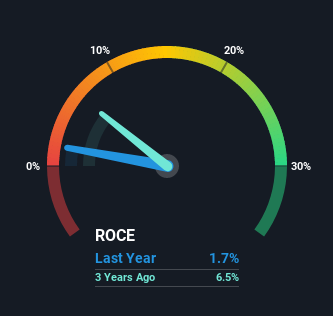- Brazil
- /
- Healthcare Services
- /
- BOVESPA:DASA3
There Are Reasons To Feel Uneasy About Diagnósticos da América's (BVMF:DASA3) Returns On Capital

There are a few key trends to look for if we want to identify the next multi-bagger. Typically, we'll want to notice a trend of growing return on capital employed (ROCE) and alongside that, an expanding base of capital employed. This shows us that it's a compounding machine, able to continually reinvest its earnings back into the business and generate higher returns. In light of that, when we looked at Diagnósticos da América (BVMF:DASA3) and its ROCE trend, we weren't exactly thrilled.
Understanding Return On Capital Employed (ROCE)
Just to clarify if you're unsure, ROCE is a metric for evaluating how much pre-tax income (in percentage terms) a company earns on the capital invested in its business. Analysts use this formula to calculate it for Diagnósticos da América:
Return on Capital Employed = Earnings Before Interest and Tax (EBIT) ÷ (Total Assets - Current Liabilities)
0.017 = R$173m ÷ (R$14b - R$3.9b) (Based on the trailing twelve months to March 2021).
Thus, Diagnósticos da América has an ROCE of 1.7%. Ultimately, that's a low return and it under-performs the Healthcare industry average of 14%.
Check out our latest analysis for Diagnósticos da América

In the above chart we have measured Diagnósticos da América's prior ROCE against its prior performance, but the future is arguably more important. If you'd like, you can check out the forecasts from the analysts covering Diagnósticos da América here for free.
What Does the ROCE Trend For Diagnósticos da América Tell Us?
On the surface, the trend of ROCE at Diagnósticos da América doesn't inspire confidence. Over the last five years, returns on capital have decreased to 1.7% from 5.1% five years ago. Although, given both revenue and the amount of assets employed in the business have increased, it could suggest the company is investing in growth, and the extra capital has led to a short-term reduction in ROCE. If these investments prove successful, this can bode very well for long term stock performance.
While on the subject, we noticed that the ratio of current liabilities to total assets has risen to 28%, which has impacted the ROCE. Without this increase, it's likely that ROCE would be even lower than 1.7%. While the ratio isn't currently too high, it's worth keeping an eye on this because if it gets particularly high, the business could then face some new elements of risk.
What We Can Learn From Diagnósticos da América's ROCE
Even though returns on capital have fallen in the short term, we find it promising that revenue and capital employed have both increased for Diagnósticos da América. And long term investors must be optimistic going forward because the stock has returned a huge 480% to shareholders in the last five years. So while investors seem to be recognizing these promising trends, we would look further into this stock to make sure the other metrics justify the positive view.
If you'd like to know more about Diagnósticos da América, we've spotted 3 warning signs, and 1 of them doesn't sit too well with us.
If you want to search for solid companies with great earnings, check out this free list of companies with good balance sheets and impressive returns on equity.
If you're looking for stocks to buy, use the lowest-cost* platform that is rated #1 Overall by Barron’s, Interactive Brokers. Trade stocks, options, futures, forex, bonds and funds on 135 markets, all from a single integrated account. Promoted
New: Manage All Your Stock Portfolios in One Place
We've created the ultimate portfolio companion for stock investors, and it's free.
• Connect an unlimited number of Portfolios and see your total in one currency
• Be alerted to new Warning Signs or Risks via email or mobile
• Track the Fair Value of your stocks
This article by Simply Wall St is general in nature. It does not constitute a recommendation to buy or sell any stock, and does not take account of your objectives, or your financial situation. We aim to bring you long-term focused analysis driven by fundamental data. Note that our analysis may not factor in the latest price-sensitive company announcements or qualitative material. Simply Wall St has no position in any stocks mentioned.
*Interactive Brokers Rated Lowest Cost Broker by StockBrokers.com Annual Online Review 2020
Have feedback on this article? Concerned about the content? Get in touch with us directly. Alternatively, email editorial-team (at) simplywallst.com.
About BOVESPA:DASA3
Diagnósticos da América
Provides diagnostic and hospital services in Brazil and Argentina.
Fair value with moderate growth potential.
Market Insights
Community Narratives



